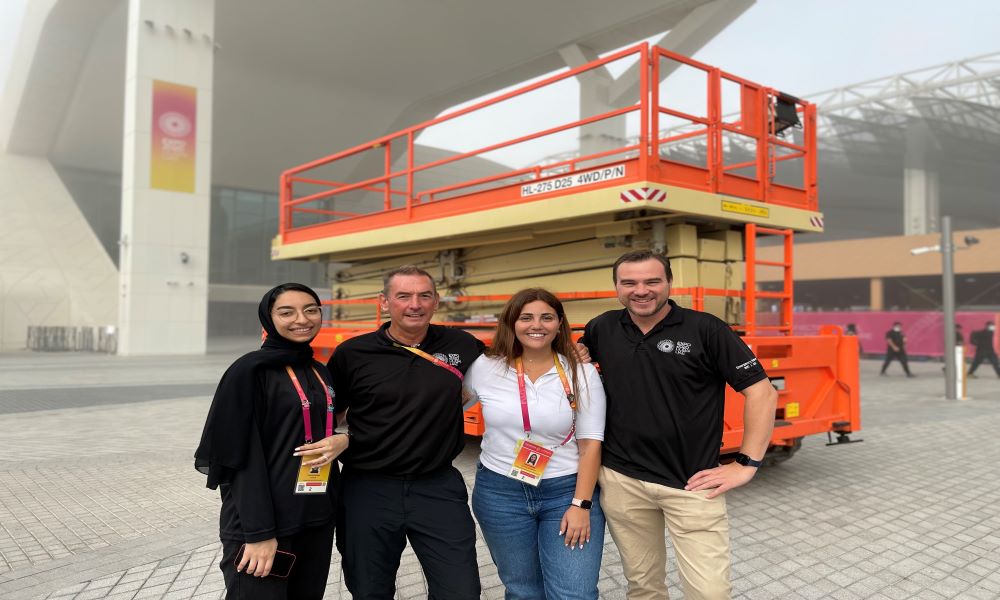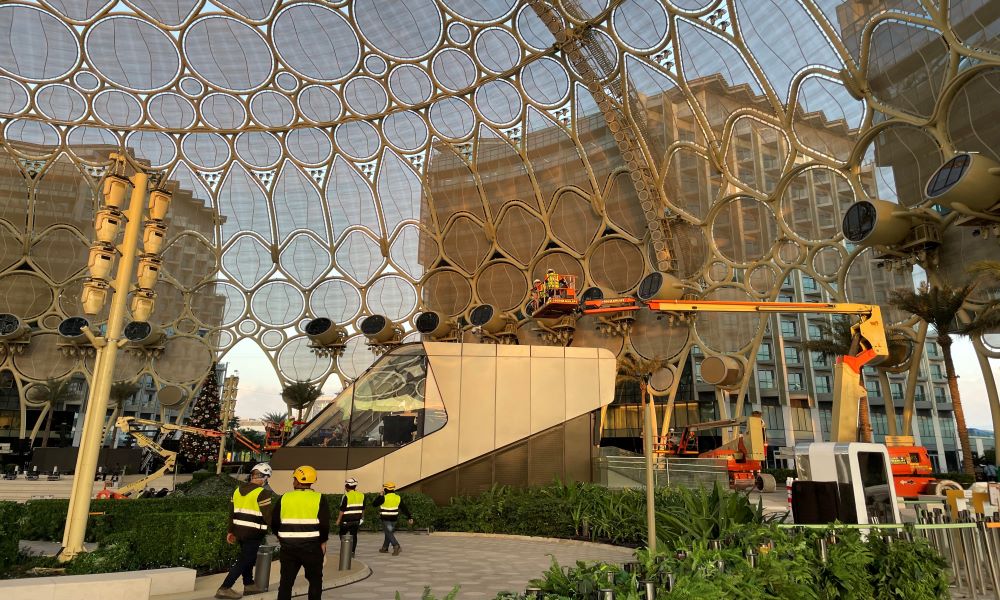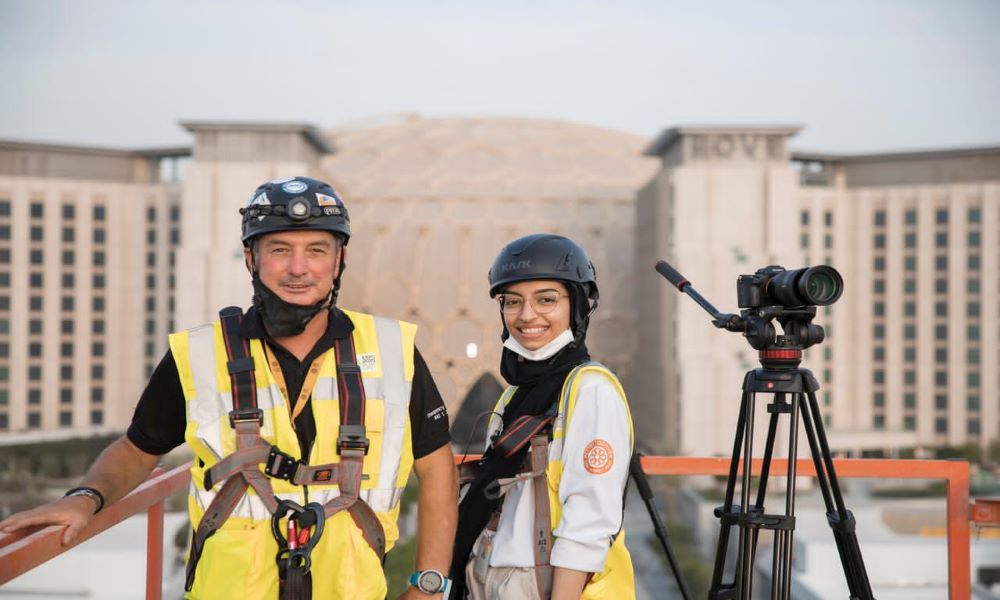It was about two months in at the biggest show on earth when Lamya Alaydaroos realised that High Access was the thing she most wanted to do. Up until then she had been combining her duties of High Access Manager with that of a Facilities Maintenance (FM) manager in the Expo’s Mobility & Jubilee zones. Yet the sheer volume of requests and different operations she was responsible for was rising at such a rate that soon she would find herself at a crossroads.
The High Access team, which had a small group of three, including Lamya, John Hyatt and Darren Williams, would eventually be responsible for more than 126 machines, over 20 contractors and 500 individuals across Expo making it the largest, longest-running and most comprehensive access-controlled MEWP project in the world. And Lamya knew that to run such a vast operation successfully she needed to be all in.
“At that moment my vision was clear that High Access required a dedicated person when tasks were overwhelming and I realised we were only three people. I needed to put all my effort and time into that. So I made a tough decision and spoke to the heads of department and said that High Access was what I wanted to do,” she explains.
Although a turning point, it was also the result of several months of preparation having joined the High Access Team as its third member in 2020 and undertaking a series of training courses such as IPAF’s MEWPS for Managers and MEWP Operator Training. It was during this time that she became the world’s first female Emirati IPAF operator, gaining the knowledge to run and manage a range of access equipment but also getting an understanding of what was required to manage a fleet operation from health and safety right down to basic communication techniques and overcoming language barriers.

“Only after that I was able to jump in to manage this team. And that took time. I remember it was only once the event had started that I was fully on board with being the manager of High Access,” Alaydaroos says.
She adds: “When I joined Expo it was 2018 in the planning phase. I joined the cleaning and waste operation, which was mainly project planning. Including policies, procedures, development of operational plans, working with the service providers to deliver these plans. I never expected to get into the high access field.”
Once the team had been put in place, one of the key contributions to the overall success of the project was an idea that Hyatt had with Manlift regarding an RFID chip in the IPAF PAL card. Traditionally a PAL card is a Powered Access License for operating Mobile Elevating Work Platforms (MEWPs), Mast Climbing Work Platforms (MCWPs) or Construction Hoists (CHs). To qualify for this, operators must complete an IPAF training course and pass a test at an IPAF-accredited training centre.
Introducing the chip allowed the High Access team to separate access between the 3A, 3B and 1B equipment categories and provide a very clear means of identification of which machines could be used, in certain places on site, and by predefined groups.

Under the system, a card reader is fit to MEWPs so when an operator swipes their PAL card a green light shows up if the machine is active. Alternatively, a red flash means the machine is outside the operator’s designated group, so use is prohibited. What it doesn’t mean, as Alaydaroos points out, is that the operator is not qualified.
“We had multiple users and each users had to work in a certain zone on site. Even if they had the qualification for a machine type, if it wasn’t in their zone and machine group, they could not use it. The zones came after working with the technical service provider. Each one of them had a zone and I had to provide each of these service providers in each of these zones. Having this system meant we could easily keep track of all our machines in each zone, and track machine utilisation. That made life easier for them as well,” she says.
With a project of this scale just getting the machines into place often involved a high volume of activity. Again, the team relied on the innovative tracking system to manage the logistics and movement of the machines to be around their corresponding zones with four compounds on site allowing the machines to always be close to users. In fact, at its peak, High Access had about 30 different operator groups across site in its bespoke trackunit programme supplied by Manlift who were instrumental in ensuring the machines were always looked after and available to the team at a moment’s notice.
When asked to explain the importance of the aerial work platform (AWP) specialist to the project, Alaydaroos pauses for a moment, as if searching for words that can sufficiently describe Manlift’s continued support throughout the event.

“We are so thankful that with our agreement with Manlift we always had technicians on site and on call during the event. I think the flexibility of Manlift in meeting our demands even at the last minute was significant. We had situations where we needed a machine and would ask Manlift to assist and they always came up with a solution.”
She adds, “When we had a machine breakdown and machines had to go back to the Manlift yard they always brought back a replacement machine for operations to still go ahead. Other than that, there was the logistical aspect of machine delivery. Manlift also helped us with the truck movement across site. We had a fleet of vehicles. Around event time we had nine recovery trucks. Their job was to go to the compound pick up a machine, drop it off and then come back and do this trip four times at least.”
During event time the High Access team always had a range of scissor lifts and boom lifts to choose from as well as the spider lifts, which were popular in certain areas because of restrictions on access and weight. For the booms, the wide scope of reach made these a highly efficient choice for most jobs. Over half the fleet was made up of electric powered machines which were charged at set points in all of the compounds for maximum utilisation.
“Because of the utilisation it was the best approach to have electric machines. As well as being more sustainable. They were less noisy and they came with non-marking tyres which prevented tyre marks on the concouses. That’s why all diesel machines had tyre covers. It’s always better to go electric,” says Alaydaroos.

Six months on from the event, Alaydaroos’ role has shifted from looking after operations to more management and audit such as adjusting the fleet according to current requirements. This month sees the official launch of Expo City Dubai as a hub for sustainability, innovation, education and entertainment, and as the transition begins to take shape there has been a noticeable reduction in the frequency of use of the MEWPS on site which has naturally led to a reduction in fleet as well. It has also given Alaydaroos some time to reflect on some of the key takeaways from running the largest access-controlled MEWP project in the world.
“Working in fleet management and events in particular, I believe adaptability is so important because of the time restrictions we had, the manpower we had and the multiple co-ordinations we had. If there is any change in plan, we just look at the situation again and find another solution.”
“You need patience,” she adds. “Training takes time. And then practice is as important to be a good operator. Agility and problem solving, too. Because you may think you have a solution to every problem but when you speak to other people you realise there are better solutions to the same problem. Especially when it comes to machine selection.”
Another on-site challenge she is quick to list is communication and having clear lines of dialogue was vital to the team during event time. “We were lucky to have a team that was actually a team even though there were multiple companies. So at event time we worked with three sub-contractors to provide manpower. The three of them had managers and supervisors that spoke English, Urdu and Arabic too. And when needed they translated to the workers on ground.”
As technology continues to evolve there is no reason to believe that equipment tracking won’t become even more refined in the future not only allowing fleet managers to monitor with greater accuracy than ever but further improving access to the machines at almost any time.
As for her own future, she knows it will be difficult to match the experience of managing high access at the world’s premier event, but she is keen to move forward and is always searching for the next challenge.
“I have spent four years here and it has been a great growth journey and that’s just from a career perspective. It’s easy that you get comfortable in a space or environment that you are very familiar, so I am always looking to challenge myself and I look forward to seeing what the next project holds.”
